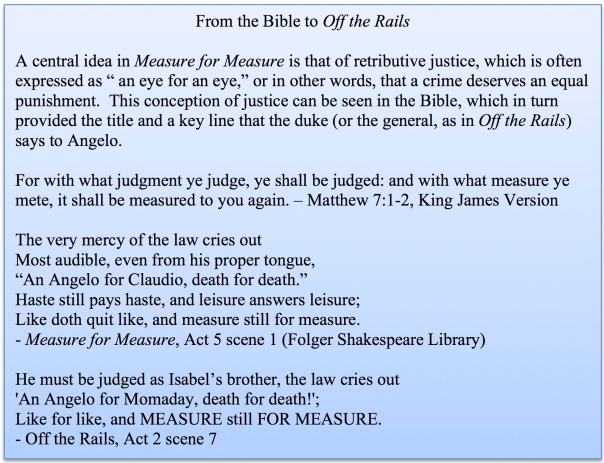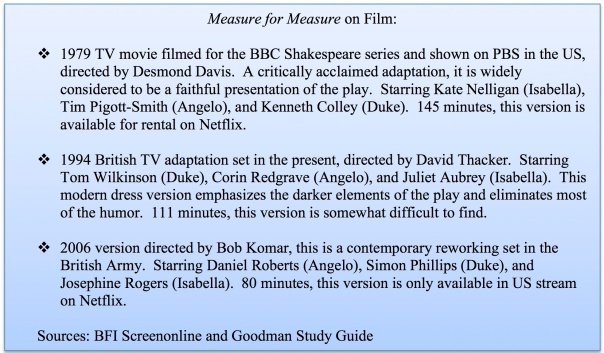By Andrea Kovich
Bringing to light a little-known chapter of American history, Off the Rails is an adaptation that filters the story of American Indian boarding schools through the lens of Shakespeare’s play, Measure for Measure. An extraordinarily fascinating play, Measure for Measure blends tragedy and comedy in a work where human nature clashes with the law and things are neither black nor white, but often occupy the hazy, gray areas of life.
The Story of Measure for Measure
The story of Measure for Measure takes place in Vienna, where the people have been allowed too much freedom by the duke, with the result that the city has become undisciplined and immoral. The duke decides to temporarily absent himself, leaving his judicial authority to the virtuous and upright Angelo, whom he expects to clean up the city and bring it to order. Once the duke is gone, Angelo reinstates an old law prohibiting extramarital sex, causing Claudio to be arrested and condemned for impregnating his girlfriend, Juliet.
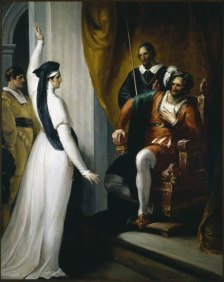
In a monastery outside of Vienna, Claudio’s chaste sister, Isabella, is about to become a nun. Before she does, she is asked to attempt to reason with Angelo to save her brother’s life. When she arrives at Angelo’s house, he justifies his decision to make an example of Claudio, which will show the people the power of the law. Isabella pleads with Angelo for mercy and he finally agrees to postpone the execution. He asks her to come back the following morning and, after she leaves, he reveals aloud that he has fallen in love with her.
Meanwhile, the duke, who has disguised himself as a friar to pass unobserved in order to see how Angelo is executing the law and to ensure that power does not change his character, visits the prison. Learning about Claudio’s crime, he questions Juliet, and determines that their intentions were good, even if the actions were unlawful.
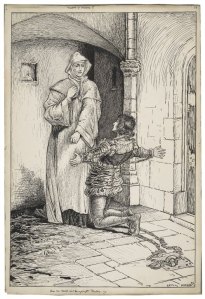
Back at Angelo’s house the next morning, Angelo gives in to his lust and makes Isabella a proposition: if she will sleep with him, then he will pardon her brother. Horrified, Isabella refuses, but Angelo gives her a day to give him her final answer. She then visits her brother and, after telling him to prepare for his death, she reveals Angelo’s proposition with the hope that Claudio would not wish her to sacrifice her virtue. At first, Claudio agrees with her refusal, but his courage wavers at the thought of death. The siblings argue but the disguised duke (duke/ friar), who has overheard everything, intervenes. Telling Claudio that Angelo was testing his sister, the duke/ friar convinces Isabella to help him right a previous wrong by pretending to agree to the proposal and Mariana, Angelo’s previously jilted fiancée, would go in her place.
This plan goes off without a hitch, however, Angelo does not keep up his end of the bargain and sends word to the prison the next morning to hasten Claudio’s execution, sending the head for confirmation. Luckily, the duke/friar convinces the prison warden to not execute Claudio, but substitute the head of another prisoner who has died earlier that morning. Isabella arrives and, concealing Claudio’s survival, the duke/ friar comforts her with a plan to expose Angelo.
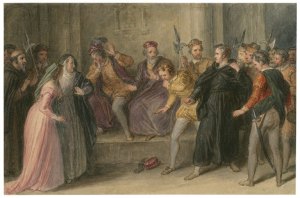
Meanwhile, Angelo receives a letter summoning him to meet the duke outside the town and to proclaim to the people that anyone who had a grievance may present his or her case at that time. Accordingly, when the duke greets Angelo and his counselor outside town, Isabella comes forward calling for justice. Pretending to dismiss her charges against Angelo as slanders, the duke orders her to be taken to prison. At this point, Mariana steps forward and it is revealed that Angelo actually slept with her. Leaving Angelo and the counselor to sort out what has happened, the duke changes into his friar habit and re-enters the scene, only to be revealed when his hood is knocked off during an ensuing scuffle.
The duke then proceeds to resolve the situation by decreeing that Angelo must marry Mariana, but that severe justice demands that he must be executed for killing Claudio. To save her husband, Mariana implores Isabella to plead for Angelo’s life, which she then does even though she believes that her brother is dead. Claudio is then revealed to be alive and the duke tells him to marry Juliet. In his final speech, the duke proposes marriage to Isabella, who does not answer.
The Context and Sources of Measure for Measure
Written during Shakespeare’s second season at the court of King James I, Measure for Measure was performed at Whitehall on December 26, 1604. As part of the Christmas revels, the play has a significant tie to the liturgical calendar, as well as the historical significance of its outset near the beginning of the new king’s reign. Following the passing of Queen Elizabeth I, her Scottish relative James ascended the throne, and he became the patron of Shakespeare’s acting company, known as the King’s Men.
The primary source for the play was George Whetstone’s Promos and Cassandra (1578), which drew from the Italian collection of short stories, The Hecatommithi (1565) by Cinthio. Shakespeare’s version closely follows the textual events in Whetstone’s Promos and Cassandra for the most part, but introduces Mariana and the so-called “bed trick” to save Isabella’s virtue (Mabillard).
The Bible also served as an important source for Shakespeare, with the biblical account of the Sermon on the Mount pervasively alluded to throughout the play.
Often called one of Shakespeare’s “problem” plays because it does not clearly fit into the categories of comedy or tragedy, Measure for Measure poses several important questions. That these questions aren’t necessarily answered within the play has frustrated some scholars, who regard the conclusion as a less than probable solution with a neat, happy ending. However, the questions deal with the primary theme of the play: the relationship between justice and mercy. Is there a way to balance these two?
Other important themes in the play are: judgment, sex, mortality, marriage, Christianity, human nature, gender, and deception. These themes are explored through the action of the main storyline and in the comic sub-plot that involves Mistress Overdone, the owner of a Viennese brothel, and her pimp.
Some other significant questions considered are: does a good outcome cancel out a terrible crime that is committed to achieve it? What is honor to life? Would Isabella’s sacrifice really save her brother, since he will have to live with the guilt, while she will have to live with the shame?
As a loosely based adaptation, the story of Off the Rails is similar to Measure for Measure in some respects, including the main action and most of the key figures involved. It also draws several lines directly from Measure for Measure, as well as quoting lines from two of Shakespeare’s greatest tragic works, Romeo and Juliet and Hamlet.

However, Off the Rails adds several new themes and questions other important issues, such as colonization and the historical treatment of Native Americans. Other important themes added are: race, power dynamics, and cultural genocide. The phrase “kill the Indian, save the man” is brought up as illustrating the forceful approach used at the boarding schools to educate the natives to become “civilized” (or “Americanized”)(“Kill the Indian, Save the Man”: Capt. Richard H. Pratt). This conflict can also be seen with the relationship of Momaday and Isabel, as Momaday tries to hold onto the traditional ways, while Isabel learns the white man’s way.
The adaptation also highlights the comic sub-plot that runs through the Shakespeare tale, but changes it to emphasize the theme of gender differences when the law prohibits women from owning businesses. As part of this, Shakespeare’s Mistress Overdone is changed to the more motherly figure of Madame Overdone and she takes the dukes role as stage manager, setting up tricks to save Momaday.
By using a classic Shakespeare play as the foundation, Off the Rails brings a touchy historical subject to the mainstream stage. Shedding light on an important topic, it allows traditionally underrepresented voices to be heard in an entertaining and engaging way. The adaptation also has the power to cause one to think and to trigger further discussion.
Works Cited
“”Kill the Indian, and Save the Man”: Capt. Richard H. Pratt on the Education of Native Americans.” “Kill the Indian, and Save the Man”: Capt. Richard H. Pratt on the Education of Native Americans. Web. 5 May 2015.
“BFI Screenonline: Measure For Measure On Screen.” BFI Screenonline: Measure For Measure On Screen. Web. 18 Apr. 2015.
Goodman Theatre Education Department. Measure for Measure: Goodman Theatre Study Guide. Print.
Mabillard, Amanda. “Shakespeare’s Sources for Measure for Measure.” Shakespeare Online. 20 Aug. 2000. Web. 4 May 2015.
“Measure for Measure.” Folger Shakespeare Library. 5 Feb. 2015. Web. 4 May 2015.
